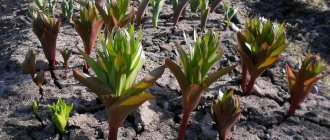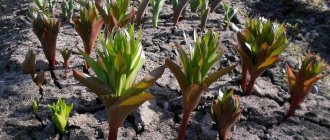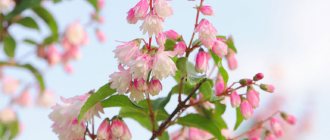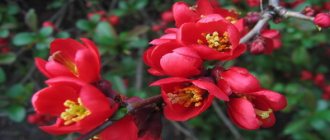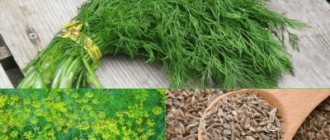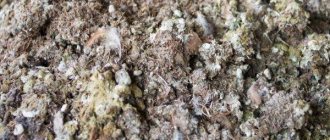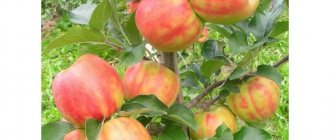Ornamental physalis is an original plant with bright orange fruit calyxes. Outwardly, they resemble Chinese rice paper lanterns. This is an unpretentious plant that is successfully used in landscape design. Thanks to the ease of care, growing physalis in your garden is not at all difficult.
Physalis - a bright decoration of the garden in autumn Source www.bloomingarden.ru
Features of the plant
Physalis is a herbaceous, fairly tall (up to 90 cm) plant with straight stems and oval, slightly tapering leaves. Among more than a hundred subspecies there are:
- edible;
- decorative, which are not intended for food.
Decorative varieties
The popularity of use in landscape design is associated with the spectacular appearance of orange-red boxes with a diameter of 60 mm with a round fruit inside. There can be up to 15 of these “lanterns” on each branch.
Of all the varieties for decorative purposes, the following varieties are most often planted:
- Physalis francheti;
- Physalis alkekengi and others.
Physalis francheti Source wikimedia.org
Lanterns left on branches for the winter become skeletonized under the influence of weather conditions. A bright berry is visible through numerous gaps in the network of veins. Decorative, spectacular branches can be used not only as a means of garden decoration, but also for interesting compositions of dried flowers, as well as crafts.
Important ! The fruits of ornamental plant varieties should not be eaten - they contain toxic substances.
Skeletonized box Source www.greenmarket.com.ua
Varieties that can be used for food
Edible varieties are divided into 2 groups:
- Vegetable.
- Berry.
Berry varieties of physalis include plants with small fruits:
- Pineapple;
- Strawberry;
- Magician;
- Columbus and others.
The annual vegetable has a good yield and has fairly large fruits - weighing up to 50 grams. The most popular varieties: Moscow early and Korolek.
Physalis vegetable Source semenaorg.ru
Only edible varieties have beneficial properties. They are rich in vitamins, proteins, microelements, carbohydrates and other substances. The berries are used raw and as decoctions for medicinal purposes.
For your information ! Berry varieties are heat-loving, while vegetable varieties are resistant to low temperatures.
Useful properties and contraindications
Composition, nutritional value, calorie content
Any physalis fruit, vegetable or berry, contains a lot of vitamins and microelements. A huge amount of vitamin C, vitamin A (14% of the daily dose required for the body), antioxidants and a unique composition of B vitamins make the plant indispensable in medical nutrition. In addition, physalis fruits are low in calories and can be used in diets for metabolic disorders accompanied by excess weight. Let's take a closer look at the benefits and harms this plant brings.
Beneficial features
To illustrate the beneficial properties of physalis, we can cite as an example the opinion of the famous folk healer Alexei.
- for stones in the kidneys and bladder - a decoction of the fruits orally;
- for gout and edema - decoction of fruits externally;
- for purulent inflammation - juice or infusion. You can use fresh berries;
- for pain in the stomach and intestines - fresh fruit puree;
- for dermatitis - physalis ointment (fruit ash mixed with vegetable oils).
Contraindications
There are no special contraindications to the use of Physalis. However, we must remember that, like any sour fruit, it can cause aggravation in patients with gastritis. Patients with pancreatic and gallbladder insufficiency also need to be careful. Diabetics should limit very sweet varieties in their menu.
Application area
As stated above, the scope of application is quite wide. You can use decoctions for flu, laryngitis, and lung diseases. Low-calorie desserts are good for dietary nutrition.
Traditional medicine recipes
Decoction
Place 30 g of dried fruits in 0.5 liters of water and cook for five minutes. Use the resulting dose for two days for kidney and bladder diseases.
Ointment
Burn dried fruits (100 g) over an open flame until ash is obtained. Grind and sift the ash. Mix with a small amount of olive oil until you obtain the consistency of an ointment. Use for healing wounds, cracks and dermatitis.
Choosing a location: how to create the best conditions
Physalis is not picky about where it grows, and can grow even in drafts, and tolerates even low temperatures. Since the decorative value of the plant lies in its lanterns, it is recommended to plant it in sunny areas. The approximate planting density is approximately 5 plants per area of 1 m².
Physalis capsules have not yet gained color Source www.jardin-adoue.com
It is advisable to choose neutral or calcareous soil. Not suitable - too wet acidified soils, as well as with close groundwater.
The soil must be prepared before planting. To do this, they add either complex mineral fertilizers or organic ones (ash, humus, compost).
When choosing a place on a personal plot, you need to take into account what garden crops were grown there before. If in previous years legumes, cabbage, cucumbers, potatoes, beets or carrots grew in the selected place, physalis will also feel good here.
For your information ! The plant cannot be planted in an area that was previously allocated for nightshade crops.
Rules for caring for ornamental plants
Decorative physalis, the cultivation and care of which is not very difficult, is often used to decorate personal plots. An adult plant is resistant to wind and drought. And it only needs watering when the weather has been dry for a long time. But newly planted physalis requires careful care.
Healthy plant Source plantscientists.com
Decorative physalis needs regular weeding, which should preferably be done at least once a month. This is due to the fact that weeds are able to “clog” the plant, which negatively affects its growth and attractiveness. You can avoid weeding by using mulching. The effect will be greater if the mulch layer is about 20-30 mm.
Fertilizers: when is the best time to apply them?
It is advisable to apply fertilizers twice a year:
- during a period of active growth;
- during the flowering period.
For these purposes, complex mineral fertilizers or humus are used. Another possible problem is the slope of the branches. If you want the stems to remain straight, they should be tied up.
Preparing for winter
The decorative qualities of physalis are the unusualness and originality of its boxes. It is important that they ripen before the onset of autumn cold weather. To do this, at the end of summer it is recommended to pinch the tops of the branches.
All the beauty of physalis Source www.ogorod.ru
For the winter, physalis is left in the ground. In autumn, the stems are cut and later used for home decoration. There is no special shelter for the plant, but it is advisable to mulch the area around it. For this purpose, fallen leaves and peat are used.
Physalis is frost-resistant, withstands frosts down to -30°C. In the spring, in the place where a beautiful bush grew last season, young shoots emerge. Over the course of a season, these “babies” recreate the plant. It can be transplanted to a new place in the spring or left in the same place and admire the bright physalis boxes in early autumn.
For your information ! Even if the above-ground part of the plant is not cut off before the cold weather, it will still die from exposure to low temperatures.
How to “keep” physalis in one place
If there is no need to expand the flower bed with physalis, then for several years (from 5 to 7) it can not be planted. Additionally, to prevent its spread, physalis can be surrounded by a border, or other improvised barriers can be used. In this case, the fence should be buried 0.2-0.3 m so that the roots do not spread to the new territory.
Once established, physalis grows quite quickly on the site. To keep this process under control, it is recommended to rejuvenate it every 5 years: divide the rhizomes and plant them in another place.
For your information ! The decorative quality of a plant directly depends on the quality of care.
The attractiveness of a mono composition Source www.ogorod.ru
general information
Physalis grows into a fairly large shrub thanks to its branching stems. The average height ranges from 60 to 120 cm. Moreover, in 1.5 months one such bush easily produces up to 150 small fruits.
Physalis is the largest genus in its Solanaceae family. In nature, it is more common in South and North America, but is already quite common in Asia and Europe. The name means “bubble” from Greek, which is easily explained by the shape of the fruit.
Among the physalis there are annuals and perennials. As they grow, the shoots become lignified, and the shrub resembles a real tree. During the flowering season, single flowers bloom along the entire length of the shoot, after which swollen spherical fruits with a characteristic aroma are formed.
In addition to its active use in cooking, physalis has many medicinal properties. And all thanks to the high content of beneficial acids and minerals. In folk medicine, even the leaves and roots of the plant are used to prepare decoctions.
Photo: pxhere.com
The use of physalis in interior design
Decorative physalis is used in landscape design of the site and as a dried flower. The plant gains decorative value when the lanterns acquire a bright orange-red color. At this stage, you can begin to prepare raw materials for future compositions.
Late autumn Source krrot.net
See also: Catalog of projects for garden houses made of kiln-dried timber
To do this, perform the following steps:
- Cut off the stems.
- Remove leaves.
- Dry for 2-3 weeks in the open air.
It is best to hang dry physalis. If the plant will be used in the form of a finished bouquet, you can tie the stems several pieces together and dry them in this form. If you need separate branches, then each stem must be hung separately.
Bright orange boxes are suitable for interior decoration Source picsart.com
For decoration, you can use not only physalis branches, but also single boxes. Wall wreaths are woven from it and used as part of New Year's compositions along with coniferous branches, craspedia, gomphrena, spikelets and other plants.
New Year's garland decor Source www.ivd.ru
Decorative wreath Source dekormyhome.ru
Composition using physalis Source www.hit-dekor.ru
The use of physalis in landscape design
Decorative varieties of physalis are used in landscape design in various compositions. From an aesthetic point of view, it is the cups with fruits that are attractive, not the flowers.
Most often, physalis is planted as an independent plant. It must be taken into account that it is better not to plant several varieties in one flower bed, since plants can interbreed. This often affects the decorative qualities of the bushes.
Site design Source rastenievod.com
It is difficult for physalis to find suitable “neighbors”. It is so unusual and bright that it will distract all attention to itself. Even stems with bolls left for the winter will serve as a bright decoration for a snow-covered garden.
Physalis looks good surrounded by low grasses that do not cover it and do not hide all the beauty and originality of the bright boxes with fruits. Very often it is used in containers placed in the garden or installed near the house, as well as in spacious flowerpots.
Growing a plant in a container Source allegroimg.com
The plant is suitable for growing even in those parts of the site that are not suitable for other crops. The green mass of its leaves is a good background for herbaceous, beautifully flowering perennials. But everything changes when the fruit pods on the physalis itself acquire a bright orange color. The main purpose of growing physalis on the site is to obtain material for creating decorative winter compositions in the house.
Important ! When working with a plant, it is necessary to take into account its toxicity.
The boxes gradually acquire an orange color Source lovely-dom.ru
Sowing
The optimal growing temperature is +20-22 degrees.
Physalis tolerates picking well, so it can be sown in common boxes. The container for sowing must have drainage holes in the bottom; the crop does not like stagnant moisture in the soil.
Before sowing, the soil is well moistened. The seeds are buried 4-5 mm; it is better to sprinkle them with clean sand. The distance between the seeds is 2-2.5 cm. The container is covered with film to maintain high humidity inside. The container is ventilated daily.
@gardengaul, Instagram
@GardenPosts
From the total container, seedlings dive into the phase of 2-3 true leaves.
Diseases and pests: problems and solutions
Physalis is not susceptible to diseases and pest attacks when properly maintained. But this does not mean that a hundred problems will never arise.
Problem #1. Increased soil moisture
If the soil is too wet, rot appears on the stem. The solution to the problem is to transplant the physalis to a place suitable for the plant.
White rot Source rastenievod.com
See also: Catalog of companies that specialize in landscape design
Problem #2. Aphid
There is also a danger of damage to perennials by aphids. This can only happen under the right conditions:
- lack of watering during prolonged drought;
- proximity to plants that are already infected with aphids.
With such damage it is necessary to use insecticides. And as a preventative measure, water as needed.
Problem #3. Late blight
Belonging to the nightshade family, physalis can be affected by late blight. External manifestations are brown spots that appear on fruits and leaves.
As a rule, such a problem occurs due to the following factors:
- thickening;
- long rains.
Late blight Source hozyain.by
The solution to the problem is to act on the warning and prevent its occurrence. To do this, plants should be sprayed even before fruit sets.
Problem #4. Blackleg
External manifestation: blackening of the sprout stem at the base. With such damage, the plant dies.
The following circumstances may lead to this:
- high humidity;
- soil acidification;
- cold air.
To prevent the problem from affecting all seedlings, you must perform the following steps:
- Remove affected shoots from the soil.
- Loosen the soil.
- Treat the soil with fungicides.
Advice ! To prevent this problem from arising, it is necessary to promptly thin out the seedlings and loosen the soil to prevent it from souring.
Black leg completely kills the plant Source dacha.help
Problem #5. Mosaic
Mosaic is a viral disease quite rare for physalis. It is caused by bacterial damage. Externally, the mosaic is manifested by a change in the color of the leaves into dark and light areas.
Ways to solve the problem:
- Remove the plant along with the roots.
- Burn the affected plant.
- The soil in the area where the affected physalis grows must be treated with potassium permanganate.
For your information ! Improper crop rotation can lead to bacterial damage.
Problem #6. Wireworm
The wireworm damages the root system of the plant. This is facilitated by acidification of the soil and the spread of wheatgrass. Adding ash to the soil and controlling weeds will help cope with the problem. This will create an environment unfavorable for the development of wireworm larvae.
Orange wireworm Source zelenj.ru
Problem #7. Medvedka
The danger of a mole cricket attack is damage to the root system. To prevent damage to the plant, you can use the following techniques:
- Throughout the summer, it is necessary to carry out high-quality loosening of 0.15 m.
- Use plants nearby that have a specific aroma and repel mole crickets. Marigolds are suitable for this.
- Watering with a solution of bird droppings has no less effect.
Medvedka spoils the roots Source 7ogorod.ru
Physalis propagation: all methods
Physalis can be bred in several ways. The simplest, with a high probability of success, is the method of dividing the rhizome, and the most labor-intensive is growing from seeds.
Young sprouts Source rastenievod.com
Growing seedlings from seeds
The start time for work is April. Before sowing seeds, they must be prepared. First, tie it in gauze and dip it in a weak solution of potassium permanganate for half an hour. At the same time, prepare the soil mixture for the seeds.
You can do this in one of the following ways:
- Calcination in the oven.
- Hot steam treatment.
Physalis seeds Source 7dach.ru
After the earth has cooled, it is poured into prepared containers. The following actions are carried out with the seeds:
- Lay out on the surface.
- Pressed.
- Sprinkle 10 mm of soil on top.
- Watered.
- Cover with glass or cling film.
The containers are transferred to a well-lit place, in which the temperature should be maintained at 15-20ºC. After the sprouts have appeared, the glass is removed.
Advice ! Seeds can be planted immediately, if possible, in separate containers with substrate.
After two true leaves appear on the sprouts, a pick is made, mineral fertilizers are applied, and watered. In the future, watering and fertilizing should be regular:
- watering - as needed;
- fertilization - every 2 weeks.
Seeds in a ripe fruit Source lovely-dom.ru
Soil preparation
Physalis has the same requirements for soil structure as tomatoes: fertile soil that does not retain moisture, with neutral acidity. Loose loam and fertile sandy loam are ideal. Heavy soils with high acidity are dug up, introducing:
- sand, up to a bucket for 1 sq. m;
- wood ash, up to 400 g;
- humus, 5-7 kg.
In the garden, physalis is sown after legumes, cucumbers and cabbage, avoiding beds in which crops of the Solanaceae family grew.
For seedlings, a “universal” substrate from the store is suitable. On their own they make up a mixture of peat, humus, turf soil, sand (perlite). The components are taken in equal shares.
After mixing, the soil is frozen outside for at least 3 months or calcined in the oven at 150 degrees. This treatment is needed to destroy infection and weed seeds.

